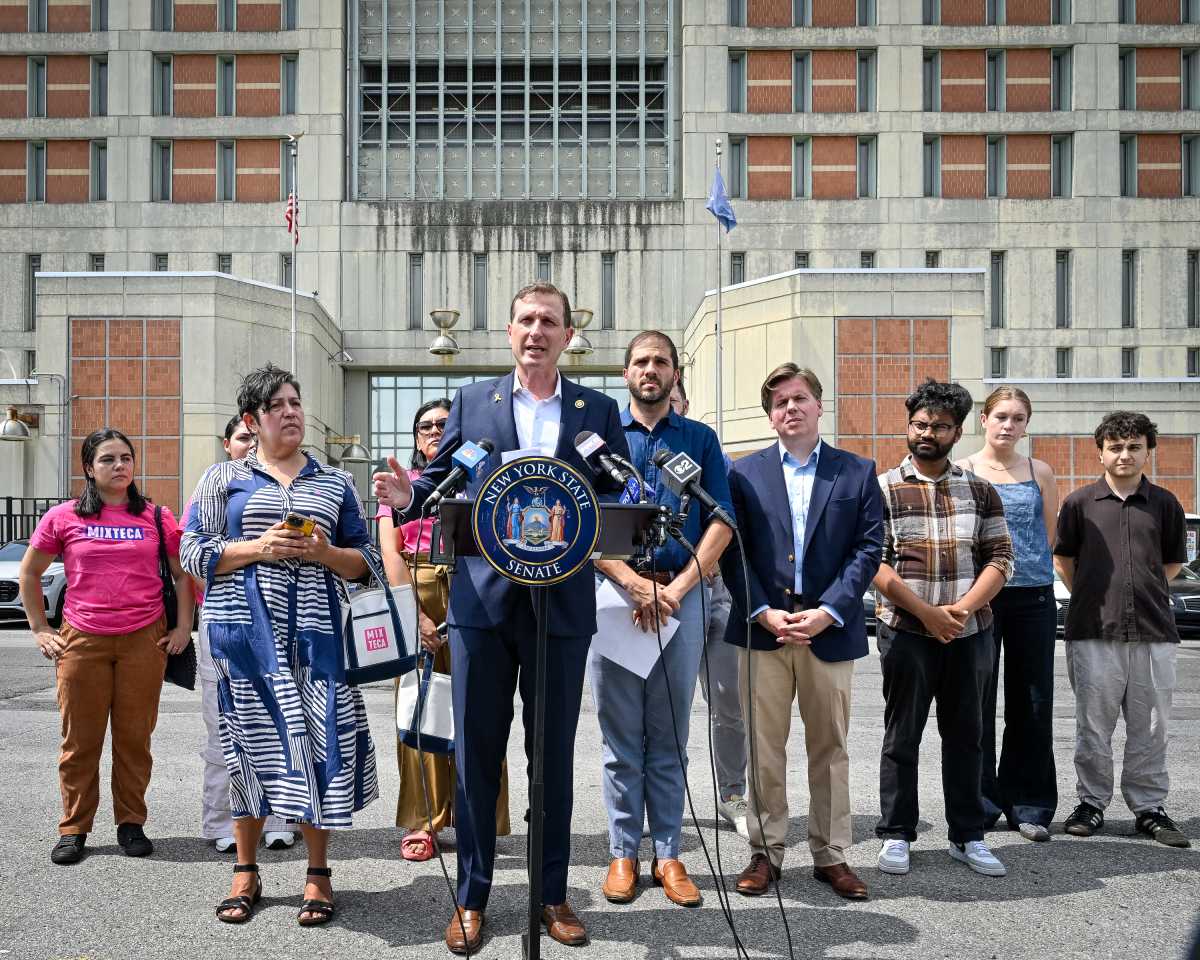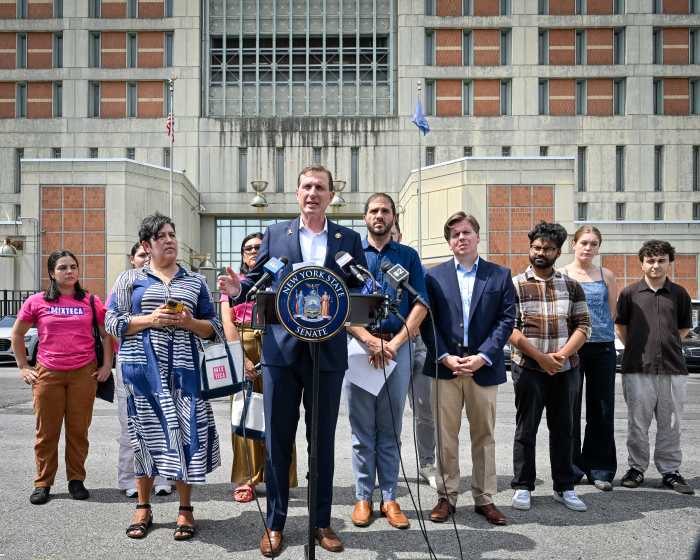By Julie Shapiro
After hearing hours of public testimony, Community Board 1 gave its support to part of a major Seaport development Tuesday night.
The board voted 23 to 16 with two abstentions to back the portions of General Growth’s project that lie within the South Street Seaport Historic District. That helps open the door for General Growth to demolish the Pier 17 mall, move the historic Tin Building from the pier’s base to its tip and build new retail and a boutique hotel up to 120 feet tall on the pier.
“The community board is pleased with the overall design,” said Roger Byrom, chairperson of C.B. 1’s Landmarks Committee. The board did not recommend any changes to the plan.
The community board’s opinion is advisory, and the Landmarks Preservation Commission has the final say. The L.P.C. held its first hearing on the project last week but has given no hint of a reaction.
Simeon Bankoff, director of the Historic Districts Council, called the community board’s approval vote a mistake.
“That was a foolish move on their part,” Bankoff told Downtown Express after the meeting. “I’m disappointed with their decision.”
Bankoff disagrees with moving the Tin Building and thinks the new 120-foot Pier 17 buildings are not in context with the rest of the historic district. Historically, pier buildings are low-scale and broad, Bankoff said, while G.G.P.’s boutique hotel is 120 feet tall. Bankoff also criticized the glass facade of some of the pier buildings.
City Councilmember Alan Gerson spoke before the board’s vote and urged General Growth to withdraw the landmarks application and go back to the drawing board. Gerson thinks the 500-foot condo and hotel tower General Growth hopes to build just north of Pier 17 is too tall for the neighborhood.
“It should not be an extension of high-rise Lower Manhattan,” he said of General Growth’s plan. “It should be an exception to high-rise Lower Manhattan.”
Barry Skolnick, a C.B. 1 member, voted against the resolution after he described recently visiting Toronto, a city that walled off its waterfront with buildings.
“I want to keep our waterfront open,” he said.
The tower was not on the agenda Tuesday night, since it sits outside of the historic district that encompasses the rest of the project.
The amenities G.G.P. has offered — including open space, a community center and a potential school — were not on the table either, since Landmarks only considers aesthetics, not uses. The tradeoff and tower discussions will happen next spring, when the project goes through the city’s Uniform Land Use Review Procedure.
More than 100 people turned out to Tuesday’s community board meeting, and nearly 40 of them spoke about General Growth’s plans, roughly half in favor and half against. Many people were angry about being silenced at a community board meeting about General Growth two weeks earlier, when time ran out before everyone could speak. At this week’s meeting, all those who arrived in the first few hours were heard. The move of the 1907 Tin Building was one of the hottest topics, with some saying they supported the project because of the move and others saying it was a deal breaker.
“Moving the Tin Building is a fantastic idea,” said Tom Brown, who has lived in the Seaport for four years. The move would put the building “in a place where you can see it, instead of under the eyesore of the F.D.R.,” he said.
Roger Bentley, who lives on Beekman St. between Front and Water Sts., agreed with Brown.
“The Tin Building is nothing but a haven for rats and garbage,” Bentley said. “It’s sad what it’s become.”
Bentley has lived near the water in Tokyo, San Francisco and Portland, Ore., and he said New York is lagging behind those cities in utilizing its waterfront.
“This is nothing more than an attempt to upgrade,” he said. As for the tower, “I don’t fear it at all.”
Although the board will not consider the tower until the spring, it got lots of attention at the hearing. Several people said the tower would diminish the stature of the Brooklyn Bridge and ruin views from the Brooklyn promenade.
“It just doesn’t fit,” said Margaret Chin, a City Council candidate who lives near the Seaport in the Financial District. “It just doesn’t look right…. People come down to the Seaport because of its history. A 40-story tower has no place in the Seaport.”
Learan Kahanov, president of the Seaport Parents Association, said he supports the project in his backyard because General Growth has shown a willingness to work with residents on a school.
“It’s the first time a major company that I’m aware of reached out directly and said, ‘What can I do?’” Kahanov said.
Several people, including Seaport residents with young children, praised the open space General Growth has pledged to include, but others said it would not feel like public space since it will be sandwiched between a private hotel and a private catering hall in the Tin Building. Both of those buildings will have retail space on the lower floors.
Ruth Porter, a 35-year Southbridge resident, noted that many of those who spoke in favor of General Growth’s project either received free space from the company or had received the promise of a future contract or amenity. Most Southbridge residents oppose the project, she said.
“How can the community board then be approving such a proposal?” she asked.
Plummeting stock
The community board’s approval was good news for Michael McNaughton, vice president of General Growth’s northeast region, but he and his crew of consultants weren’t heading out afterwards to celebrate.
“I’m beat,” McNaughton said as he left the meeting after 8 p.m. “It’s been a rough few months. But I feel more enthusiastic today than I have.”
Asked if G.G.P.’s tumbling stock price might have something to do with his exhaustion, McNaughton shook his head no. He pointed out that the company’s stock, which reached a low of $1.97 on Monday, had jumped above $4 Tuesday and closed at $3.39.
“The markets have spoken,” McNaughton said triumphantly.
Still, for a stock that traded comfortably above $30 for much of the last year and peaked at nearly $55, the modest rise isn’t likely to quash rumors that the company will be sold. (The stock also dropped again on Wednesday, to close at $2.99.)
General Growth has $27 billion of debt and this week put its Las Vegas properties on the market. Bernard Freibaum, the company’s C.F.O., resigned several weeks ago, and this week C.E.O. John Bucksbaum, whose family founded General Growth, also stepped down, along with President Robert Michaels. General Growth disclosed this week that Michaels and Freibaum had taken improper loans from a Bucksbaum family affiliate to cover their personal margin debts from the falling stock. The loans were reportedly against company policy, but not against the law.
Regarding the company’s stock difficulties, McNaughton said Tuesday “It is not a G.G.P. issue,” since the economy is suffering worldwide. “We are a viable organization,” he said.
McNaughton previously told Downtown Express that the Seaport redevelopment is General Growth’s first priority. Asked Tuesday if that means the Seaport would be the last property G.G.P. would ever put up for sale, McNaughton said, “I would like to believe that.”
At Tuesday’s community board meeting, many people raised the question of G.G.P.’s finances.
Margaret Cooney, a 32-year Southbridge Towers resident, said G.G.P.’s assurances of viability didn’t mean anything. Cooney worked at Bear Stearns before its collapse and sale to JPMorgan Chase earlier this year. She recalled watching the stock go “down and down and down” on her computer monitor and listening to executives reassure the staff that the company was fine even as they dragged boxes out of the building.
Now, Cooney said, “I’m watching General Growth’s stock go down and down and down…. This does have a bearing on General Growth and what they will be able to do for our community.”
The community board agreed, and the resolution they passed includes many references to “G.G.P. or any subsequent developer.”
“There is a strong likelihood we will be negotiating with other owners,” said Byrom, chairperson of the Landmarks Committee. Byrom wants to make sure General Growth’s commitments about amenities would apply to any future owner. “We don’t want them to say, ‘Oh, I’m sorry, I can’t afford that,’” Byrom said.
Extend the district?
Two weeks ago, the community board met to pass a resolution on General Growth’s plans, but the board could not come to a consensus and seemed close to rejecting at least part of the proposal. At that meeting, the board tried to pass several resolutions that included a controversial suggestion: The board wanted to extend the Seaport Historic District to encompass the New Market site, where General Growth wants to build the tower. If the city went along with that proposal, which is unlikely and would take years to implement, General Growth’s tower would become all but impossible.
The community board omitted the historic district extension from Tuesday night’s resolution, but Paul Hovitz, a board member and Southbridge resident, proposed it from the floor as an amendment.
“I think it’s only proper that the entire pier be in the historic district,” Hovitz said. “I have a big problem that the loophole is not closed…. This is something the city should have done a long time ago.”
During the public session, several other Southbridge residents agreed. The Southbridge Towers board helped pay for studies that led to the 2003 rezoning of the Seaport Historic District with a 120-foot height limit. Many people thought the rezoning, combined with waterfront zoning, would prevent a new tower along the water. But the loophole Hovitz referred to is the fact that the platform where General Growth wants to build the tower has a much higher height limit of 350 feet. The firm hopes to get a special permit in order to build 500 feet.
Diane Harris Brown, a Southbridge resident, said the community board, which fought for the rezoning, was flip-flopping now in its support of the project.
“It is short-sighted and rather unbelievable,” she said. “It would be an outrage to have a luxury high-rise [on the water].”
Byrom, Landmarks chairperson, disagreed with Hovitz’s amendment. Byrom said putting the tower site in a historic district could make the entire project unviable.
Julie Menin, chairperson of the board, agreed. “The time to oppose the tower is at ULURP,” she said, but several people in the audience called out “No!”
Bruce Ehrmann, co-chairperson of the Landmarks Committee, concurred that Hovitz’s resolution would destroy the project, which he said would ignore the wishes of many residents who want it to move forward.
Hovitz replied that the residents of Southbridge Towers are firmly against the project, and he doesn’t want to ignore them either.
Ehrmann gestured around the Southbridge community room, where the meeting was held, and asked rhetorically, “How many towers are here?”
The board then voted Hovitz’s amendment down by a roughly 2-to-1 margin, leaving the original resolution to pass unchanged.
Julie@DowntownExpress.com































